If you live in the UK but aren’t a British citizen and can’t get a passport from your home country, you might be able to get travel documents from the British Home Office if you need to travel outside the country. Generally, you’re only eligible for travel documents if you’re staying in the UK as a refugee or stateless person, or if you’re settled in the UK permanently (what the Home Office calls “indefinite leave to remain”). You can apply for travel documents online through the Home Office, but you have to mail the completed application along with supporting documentation. If you don’t have a biometric residence permit (BRP), you’ll need to apply for one of those when you apply for your travel document.[1]XTrustworthy SourceOfficial UK government websiteOfficial website for the public sector of the UK governmentGo to source
StepsPart 1Part 1 of 3:Choosing the Right Travel Document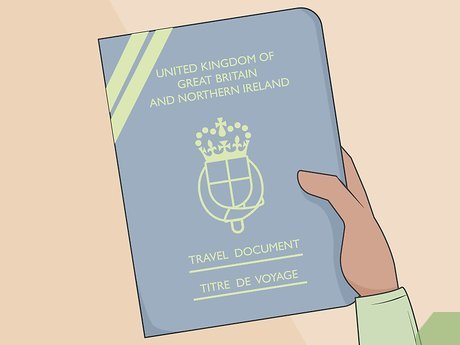
1Apply for a 1951 UN Convention travel document if you are a refugee. If your application for asylum was granted and you are recognized as a refugee, you qualify for this travel document. It has a blue cover.[2]XResearch sourceThis travel document is typically valid for up to 10 years, depending on the validity of your biometric residence permit (BRP). You can travel to any country except your country of origin.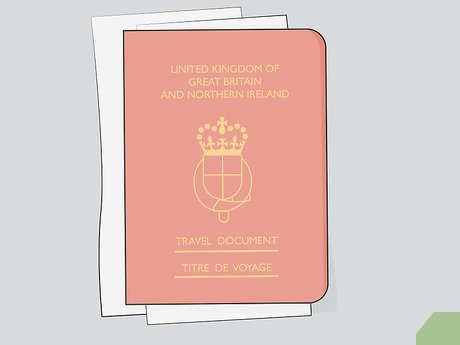
2Use a 1954 UN Convention travel document if you are “stateless.” If you have been officially recognized as “stateless” by the UK government under the terms of the 1954 UN Convention Relating to the Status of Stateless Persons, you qualify for this travel document. It has a red cover.[3]XResearch sourceStateless travel documents are usually valid for 10 years, although they might be issued with a shorter validity depending on your situation. You can typically travel to any and all countries.You’re only considered stateless if you are not recognized as a citizen of any country. Some refugees are stateless, but not all. If you’re not sure if you’ve been officially recognized as stateless, you probably haven’t. Fewer than 100 people in the UK have been recognized as stateless since the official determination procedure was started in 2014.[4]XResearch sourceAdvertisement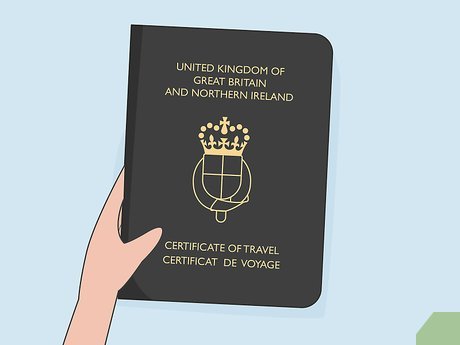
3Try a Certificate of Travel (COT) if you aren’t a refugee or stateless person. If you don’t qualify for either of the UN convention travel documents, you might be able to get a COT. However, these travel documents are only available if you can prove with documentary evidence that you were unreasonably refused a passport from your home country.[5]XResearch sourceTo get this documentation, apply for a passport using your home country’s usual process. When your application is denied, save the original letter you get back from your home country.You also need to show why the denial was unreasonable. The Home Office considers a denial reasonable if, for example, you have a criminal record in your home country or did not provide enough evidence to confirm your identity.If you are granted a COT, it will typically have 5 years of validity. You can travel to any country with this document except for your country of origin.
4Get a one-way travel document if you want to leave the UK permanently. Getting enough evidence together for a COT can be difficult. However, if you’re not planning on returning to the UK, you can apply for a one-way travel document that will allow you to leave the country.[6]XTrustworthy SourceOfficial UK government websiteOfficial website for the public sector of the UK governmentGo to sourceWhile you do need to provide documentation to confirm your identity, you don’t need to apply for a BRP to use this type of travel document.This document is issued to any non-British citizen in the UK who doesn’t have a passport and wants to leave the country. It can only be used for one journey out of the country and is valid for a year, although it’s generally intended to be used immediately.[7]XResearch sourceOne-way travel documents are typically issued for travel to a specified country. If you have to travel through one country to get to your destination country, that country will also be listed on your document.AdvertisementPart 2Part 2 of 3:Filling out Your Application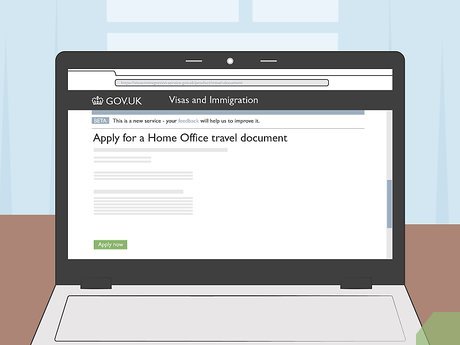
1Visit the Visas and Immigration website to start your application. Go to https://visas-immigration.service.gov.uk/product/travel-document and click the green button at the bottom of the page with the words “Apply now.” You will then be asked about your location. Click the circle next to “yes” if you are currently in the UK.[8]XTrustworthy SourceOfficial UK government websiteOfficial website for the public sector of the UK governmentGo to sourceAfter you provide your location, you’ll be asked to select which type of travel document you want to apply for. If you’re not sure, click on the question so see who qualifies for each type.
Tip: If you don’t feel comfortable using a computer or do not have internet access, you can get help over the phone by calling 03333 445 675. This phone line is open Monday through Friday from 9:00 a.m. to 5:00 p.m.
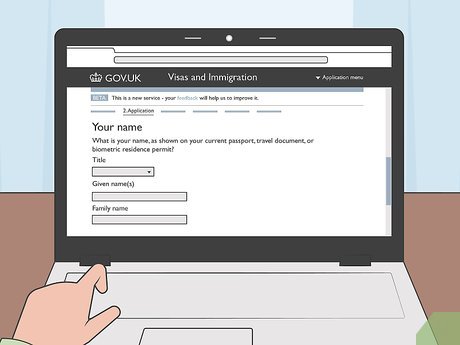
2Enter your answers to the questions on the application. The application requires you to provide information about your identity and citizenship status. If you’re a refugee or stateless person, you’ll need to provide information about that as well. You’ll also need to describe where you’re planning to travel and the purpose of your trip.[9]XResearch sourceIf you’re applying for a one-way travel document, your document will only be valid for travel to the country you specified. However, all other travel documents are typically valid for travel to any country, except your country of origin or the country from which you sought asylum.If you’re applying for a COT, you’ll also need to discuss your process of applying for a passport from your country of origin and the reason your application for a passport was denied.
Tip: If members of your family are also applying for travel documents at the same time, you each have to apply online and pay your fees separately.
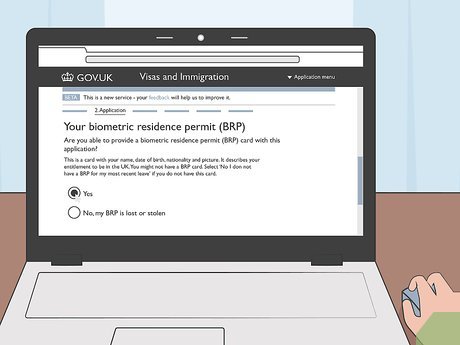
3Fill out the BRP portion of the application if you don’t have a BRP. Unless you’re applying for a one-way travel document, you must have a BRP to re-enter the UK with travel documents. The BRP application is part of the travel document application and requires you to provide additional information about your identity.[10]XTrustworthy SourceOfficial UK government websiteOfficial website for the public sector of the UK governmentGo to sourceThe online application will ask you if you have a BRP. If you do, simply answer “yes.” If you answer “no,” the BRP application will come up for you to fill out.You will have to provide a digital photo and digital fingerprints along with your signature for your BRP. You can get these done at any government service and support center or post office branch. As of January 2020, the fee is £19.20 for biometrics.[11]XTrustworthy SourceOfficial UK government websiteOfficial website for the public sector of the UK governmentGo to source
Warning: If you already have a BRP but need to amend or replace it, you must do this before you apply for your travel document. You can’t use the application included with the travel document application.

4Pay your application fees online to complete your application. When you finish filling out your application, the website will prompt you to pay your application fees. If you don’t already have a UK bank account, you may want to open one up using your BRP for identification. You can also use a prepaid card. As of January 2020, application fees are as follows:[12]XResearch sourceRefugee and stateless person’s travel documents are £75 for adults, £49 for children under 15, and £0 if you were born before September 1, 1929.One-way travel documents are £75 for all adults (regardless of age) and £49 for children under 15.A COT is £280 for all adults (regardless of age) and £141 for children under 15.AdvertisementPart 3Part 3 of 3:Submitting Your Application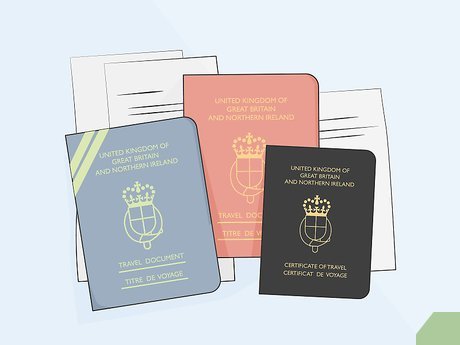
1Gather original documents to support your application. The specific documents you’ll need depend on the type of travel document you’re applying for. For a one-way travel document, you typically need the least documentation. You’ll only need something that proves your identity, such as your BRP or your passport from your home country.[13]XTrustworthy SourceOfficial UK government websiteOfficial website for the public sector of the UK governmentGo to sourceIf you’re applying for a travel document as a refugee or stateless person, you’ll need the British court order or certificate that shows you’ve been officially recognized as a refugee or stateless person, as well as your BRP.If you’re applying for a COT, you need documents that prove that you applied for a passport from your home country and that application was unreasonably denied. This might include a letter from your home country’s immigration authority or a copy of your passport application. A COT typically requires the most documentation.
Tip: Make a photocopy of your BRP to send with your application — do not send your original BRP. All other documents must be originals.

2Get documents translated if they aren’t in English. If you’re applying for a COT, you likely have documents from your home country’s passport office that are not in English. These need to be translated by a professional translator. Include the translation along with the original.[14]XResearch sourceThere are many translation companies in the UK that offer professional translation services. You can find these companies with a quick internet search. You might also use the search engine provided by the Institute of Translation and Interpreting, a professional association of translators. Go to https://www.iti.org.uk/component/itisearch/?view=translators to find a translator who is a member of the association.
3Print your application and sign the declaration in black ink. Even though you completed the application online, you have to submit a paper copy to the Home Office. You cannot send it electronically. On the last page, there is a declaration with a box for your signature. Make sure your signature doesn’t touch or cross any of the lines of the box.[15]XResearch sourceYour signature will be scanned and digitally included on your travel documents.After you’ve signed your declaration page, make a photocopy of your entire application so you have it for your records.
4Email or fax evidence to support a priority request. It typically takes several months for the Home Office to process your application and issue your travel document. If you need it sooner, submit documents showing why you need your travel document as soon as possible. Examples of documents you might send include a doctor’s letter, recent death certificate, or recent medical report.[16]XResearch sourceScan the document and email it to [email protected] or fax it to 020 8196 0109.You still must include the paper originals of any documents you fax or email in your package that you send to the Home Office.
5Send your package using Royal Mail Signed For service. Put your application and supporting documents together in a single package. Using Royal Mail Signed For service allows you to track your package so you know when it’s received. You can also use Special Delivery.[17]XResearch sourceSend your documents to:Travel Documents SectionUK Visas and ImmigrationLunar House40 Wellesley RoadCroydonCR9 2BYAfter verifying the information in your application, the Home Office returns documents that don’t need to be kept with your application. If you want these documents returned to you by Special Delivery, include a prepaid Special Delivery envelope with your package.If you realize after you’ve sent your package that you left out a document, don’t send it separately. Instead, wait to hear back from the Home Office. They will send you a letter to request any documents that are missing from your application package.
6Wait for your travel document to arrive. If your application is denied, the Home Office will send you a letter explaining the reason for the denial. You are free to apply again. If your application is successful, the Home Office will send your travel document to you using Royal Mail Signed For service. You’ll have to sign to accept this package.[18]XResearch sourceIt typically takes 3 to 4 months for the Home Office to process an application for a travel document.[19]XResearch source
7Write to the home office if you’ve waited longer than 14 weeks. Include your full name and the type of travel document you’ve applied for along with the date you sent your application. Explain that you haven’t heard back and would like to know the status of your application.[20]XResearch sourceIf you’re writing a physical letter, mail it to:Travel Documents SectionUK Visas and ImmigrationLunar House40 Wellesley RoadCroydonCR9 2BYYou can also send an email to [email protected]








